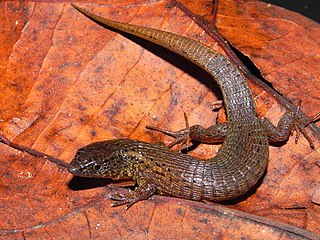
Alopoglossus is a genus of lizards in the monogeneric family Alopoglossidae. The genus is distributed from Costa Rica in Central America to northern South America.

Hyphessobrycon is a genus of freshwater fish in the family Characidae. These species are among the fishes known as tetras. The genus is distributed in the Neotropical realm from southern Mexico to Río de la Plata in Argentina. Many of these species are native to South America; about six species are from Central America and a single species, H. compressus is from southern Mexico.

The Miridae are a large and diverse insect family at one time known by the taxonomic synonym Capsidae. Species in the family may be referred to as capsid bugs or "mirid bugs". Common names include plant bugs, leaf bugs, and grass bugs. It is the largest family of true bugs belonging to the suborder Heteroptera; it includes over 10,000 known species, and new ones are being described constantly. Most widely known mirids are species that are notorious agricultural pests that pierce plant tissues, feed on the sap, and sometimes transmit viral plant diseases. Some species however, are predatory.
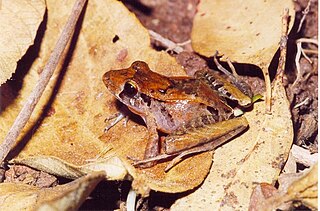
Ischnocnema is a genus of frogs from eastern Brazil and north-eastern Argentina. They comprise the former Eleutherodactylus from this region, but they are closer to Brachycephalus than the "true" Eleutherodactylus. Consequently, they are now placed in their own genus Ischnocnema in the family Brachycephalidae.

Adenomera is a genus of leptodactylid frogs, sometimes known as tropical bullfrogs, found in South America east of the Andes. The genus was until recently considered a synonym of Leptodactylus.

Leptodactylus is a genus of leptodactylid frogs. It includes the species commonly called ditch frogs or white-lipped frogs. It is very similar to Physalaemus, a close relative, and indeed the 2005 described Leptodactylus lauramiriamae is in some aspects intermediate between them. The name means ‘slender finger’, from leptos and the Greek daktylos.

The minute tree-fungus beetles, family Ciidae, are a sizeable group of beetles which inhabit Polyporales bracket fungi or coarse woody debris. Most numerous in warmer regions, they are nonetheless widespread and a considerable number of species occur as far polewards as Scandinavia for example.

Fluviphylax is a genus of tiny poeciliids native to the Amazon Basin, Orinoco Basin, and Oyapock Basin in South America.
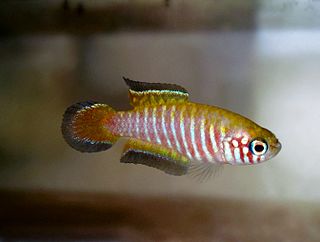
Simpsonichthys is a genus of killifish from the family Rivulidae the species of which are endemic to temporary freshwater habitats like ponds in the upper Paraná, upper Araguaia, upper Jequitinhonha and São Francisco basins on the central Brazilian Plateau. They are small annual killifish that reach up to 5.5 cm (2.2 in) in standard length.

Phylinae is a subfamily of the plant bug family Miridae. Species of this family are found worldwide.
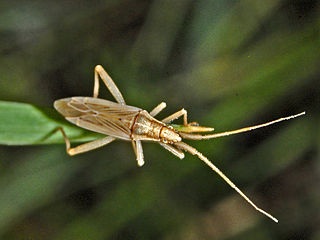
Stenodema is a genus of Palaearctic, Oriental and Nearctic plant bugs in the family Miridae and the tribe Stenodemini.

Macrolophus is a genus of plant bugs in the family Miridae. There are at least 20 described species in Macrolophus.
Sericophanes is a genus of plant bugs in the family Miridae. There are more than 20 described species in Sericophanes.
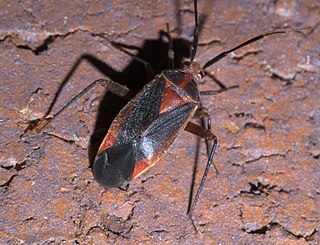
Taedia is a genus of plant bugs in the family Miridae. There are more than 80 described species in Taedia.

Ilnacora is a genus of plant bugs in the family Miridae. There are more than 20 described species in Ilnacora.
Eustictus is a genus of plant bugs in the family Miridae. There are more than 30 described species in Eustictus.
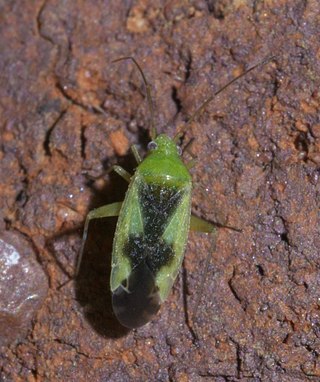
Reuteroscopus is a genus of plant bugs in the family Miridae. There are more than 50 described species in Reuteroscopus.
Itapeuasaurus is a genus of rebbachisaurid sauropod dinosaur from the Alcântara Formation of Maranhão in Brazil. The type and only species is Itapeuasaurus cajapioensis. It is the most complete Cenomanian-aged diplodocoid known from South America and it is also the first reported Cenomanian-aged rebbachisaurid discovered in South America.

Monalonion is a genus of bugs in the family Miridae and tribe Dicyphini.

The Ommatolampidinae are a subfamily of grasshoppers in the family Acrididae, found in central and South America, and based on the type genus Ommatolampis. Derived from the "Ommatolampides" used by Brunner von Wattenwyl in 1893, the first use of the name in its current form was by Rodríguez et al. in 2013; this taxon appears to be paraphyletic.
















